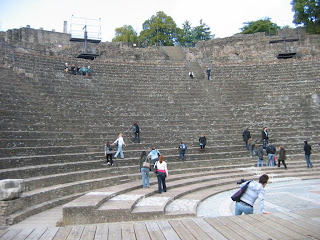





On Friday we left on an early train for Marseille and an overnight stay that permitted two days of exploration. We had beautiful, sunny weather that allowed everyone to experience the famous “Mediterranean light” and the stunning views of the city and the port. After dropping our bags at our little hotel, we made directly for the Vieux Port and took Le Petit Train (yes, one of those little tourist trains) that went up, up, up, to Notre Dame de la Garde, the grand basilica that is the highest point of the city (154m). It was breath taking! The Mediterranean was many shades of blue, and we could see the entire city, the port, and distant mountains as well as experiencing the gale-like wind.
After the train brought us back to the port (accompanied by gypsy music), we made a trek to La Plage Catalan to put our feet onto the Mediterranean (there were two elderly women having their daily swim and even some sunbathers) and spent time strolling, café-sitting, and reading the posted menus at the port restaurants in order to decide where to sample bouillabaisse and moules. After dinner (which begins late, especially in the south) we all returned to our hotel together because as beautiful as it is, Marseille is safer for women in a large group, than in ones and twos.
The next day we got perhaps more advice than we needed about what to do next from a proud (and tipsy) Marseillais that we met as we had café and croissants not far from the hotel. When we finally escaped we went down to the port to see the Saturday market of fresh (usually still wiggling) fish. Again, the colors of everything just seemed in some way saturated by the sunshine and the light reflected off the water. We went on to a walking tour that included Le Panier, the city’s old quarter, the Cathedral Major, and the Vieille Charité, where there was a special exhibition: Van Gogh Montecelli that showed the influence that Montecelli appeared to have had on Van Gogh. After a stop for lunch, we also spent time at the Musée Cantini that housed relatively contemporary art. We had this museum almost to ourselves and could range around comfortably and discuss what we were seeing. We spent our last couple of hours in the Vieux Port drinking in the sunshine and relaxing at cafes before heading back to Lyon on the TJV train weary, but full of new experiences.















